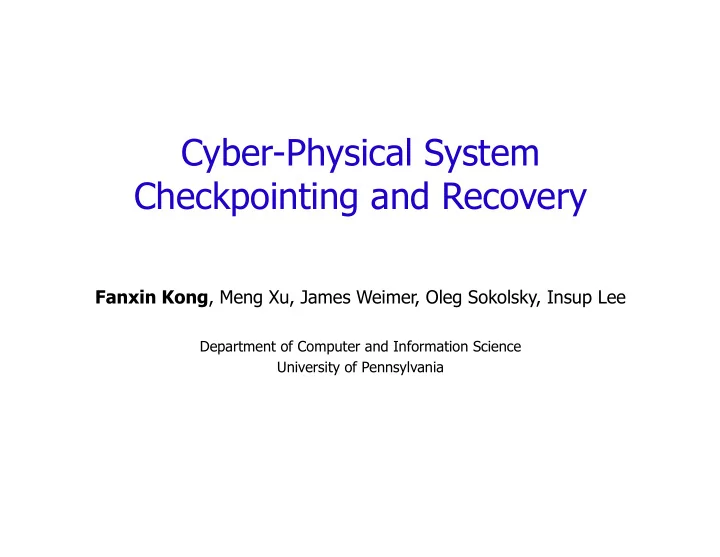

Cyber-Physical System Checkpointing and Recovery Fanxin Kong , Meng Xu, James Weimer, Oleg Sokolsky, Insup Lee Department of Computer and Information Science University of Pennsylvania
Cyber-Physical System Checkpointing and Recovery Fanxin Kong , Meng Xu, James Weimer, Oleg Sokolsky, Insup Lee Department of Computer and Information Science University of Pennsylvania
Security 2
CPS Attack Surfaces • Cyber attack surfaces e.g., communication, networks, - computers, ... • Environmental attack surfaces e.g., GPS signal, electro- - magnetic interference, ... • Physical attack surfaces e.g., locks, casings, cables, … - • Human attack surfaces e.g., phishing, blackmail, … - Smart Power Grid 3
Outline • What we study • Our idea: checkpointing and recovery • Design for recovery • Checkpointing protocol design • Evaluation 4
What we study and why? Target : Sensor Attacks Physical system • The attacker can arbitrarily change sensor measurements Malicious Actuator Sensor - environmental attack surfaces signals - cyber attack surfaces Malicious packets Network Controller 100mi/h 30mi/h 5
What we study and why? Target : Sensor Attacks Physical system • The attacker can arbitrarily change sensor measurements Malicious Actuator Sensor - environmental attack surfaces signals - cyber attack surfaces Malicious Goal : Resilience packets Network • To ensure control performance with sensor attacks Controller 6
Ideally… Speed sensor attack • Ideally, the system performs (almost) the same as if there is no attack - Example: cruise control under a speed sensor attack 7
How sensor attacks affect control? Controller Sensor Physical system Actuator 1. A sensor attack or fault occurs 4. The actuator performs the misled actuation 5. The physical system drifts off 8
Limitations of Existing Approaches • Existing approaches rely on sensor redundancy - Multiple sensors (partially) measure the same physical variables • Existing approaches limit the number of compromised sensors - E.g., less than half of the total number of sensors In question: how to handle the case that violates these limitations? 9
Outline • What we study • Our idea: checkpointing and recovery • Design for recovery • Checkpointing protocol design • Evaluation 10
My idea: checkpointing and recovery Controller Sensor Physical system Actuator • Recovery: restore the system so that state estimations / predictions correctly reflect the system’s physical states Advantage: no need to modify the controller 11
Can we apply roll-back recovery directly? • It is often infeasible to roll back a CPS system - e.g., power flow in the power grid - irreversible processes 12
Can we apply roll-back recovery directly? • It is often infeasible to roll back a CPS system - e.g., power flow in the power grid - irreversible processes • Physically rolling back physical states incurs considerable overhead and usually unnecessary - e.g., speed sensor attack Roll-back Better 13 -- desired speed
Outline • What we study • Our idea: checkpointing and recovery • Design for recovery • Checkpointing protocol design • Evaluation 14
Propose roll-forward recovery Physical-State Recovery: Rolling the system to the current time by starting from a consistent global physical-state. Prediction using historical state Estimated speed 15
How does it work? • Idea: model-based prediction E.g., A linear time-invariant system By prediction (step 1, 2) Unchanged Step 1: predict the current state Step 2: recover the faulty state 16
Outline • What we study • Our idea: checkpointing and recovery • Design for recovery • Checkpointing protocol design • Evaluation 17
What kind of states is used? Cyber state: logical consistency Message send-receive Physical state: timed consistency Difference of timestamp 18
Which consistent state is used? detection window ? ? … used for recovery pending detection • States that pass detection can be used for recovery • Attack detection usually has substantial delay • States during the detection interval may be incorrect • Idea: use states outside detection window for recovery 19
Checkpointing CPS • A sliding window based protocol detection window ? ? ? … ? deleted states deleted states buffered states buffered states the stored state the stored state • Step 1: states are buffered, before passing the detection • Step 2: the state is stored, after passing the detection • Step 3: stored states are discarded, if no longer needed 20
The overall system design Physical checkpointing system YES NO attacked recovered YES NO ? prediction recovery Controller • Recovery-based control: predict future states based on the recovered state time Normal operation Recovery Recovery-based 21 control
Outline • What we study • Our idea: checkpointing and recovery • Design for recovery • Checkpointing protocol design • Evaluation 22
Scenario: lane keep • Testbed: an unmanned vehicle. Each front wheel is driven by a motor, and each motor has a speed sensor • Goal: to keep a vehicle travel in a straight line, i.e., the two front wheels have the same speed • Controller: a PID controller supervises and controls the speed difference of the two front wheels • Attack: the attacker modifies a speed sensor’s measurements to a constant value 23
How well does it work? No protection difference speed large The vehicle keeps turning With protection difference recovery speed small The vehicle travels almost straightly 24
Summary • Goal: Securing Cyber-Physical Systems • CPS Checkpointing and Recovery • A Roll-forward Recovery • A Sliding-Window Based Checkpointing Protocol • Case Study: Sensor Attacks on Automobiles Thank you! 25
Recommend
More recommend